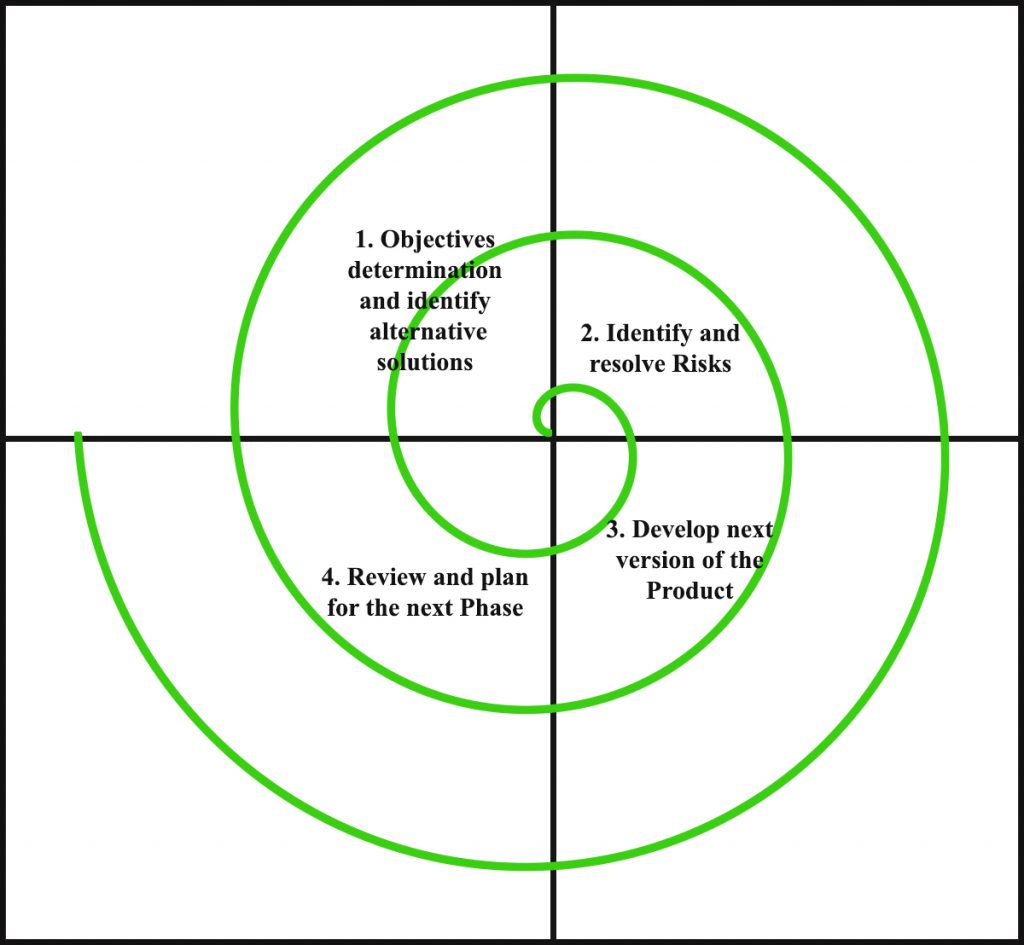engineering 3d drawings spiral notation
Spiral model is one of the nigh important Software Development Life Cycle models, which provides back up for Risk Handling. In its diagrammatic representation, it looks similar a spiral with many loops. The exact number of loops of the spiral is unknown and can vary from project to projection. Each loop of the spiral is called a Stage of the software evolution process. The exact number of phases needed to develop the product tin exist varied by the project manager depending upon the project risks. Every bit the projection manager dynamically determines the number of phases, so the projection director has an important part to develop a product using the spiral model.
The Radius of the spiral at any point represents the expenses(price) of the project so far, and the angular dimension represents the progress made and so far in the current phase.
The beneath diagram shows the unlike phases of the Screw Model: –

Each phase of the Spiral Model is divided into four quadrants as shown in the above figure. The functions of these iv quadrants are discussed below-
- Objectives conclusion and identify alternative solutions: Requirements are gathered from the customers and the objectives are identified, elaborated, and analyzed at the start of every phase. And so alternative solutions possible for the stage are proposed in this quadrant.
- Identify and resolve Risks: During the second quadrant, all the possible solutions are evaluated to select the all-time possible solution. Then the risks associated with that solution are identified and the risks are resolved using the all-time possible strategy. At the cease of this quadrant, the Image is built for the all-time possible solution.
- Develop adjacent version of the Production: During the 3rd quadrant, the identified features are adult and verified through testing. At the terminate of the third quadrant, the adjacent version of the software is bachelor.
- Review and plan for the next Phase: In the fourth quadrant, the Customers evaluate the and then far adult version of the software. In the end, planning for the side by side stage is started.
Risk Handling in Screw Model
A hazard is whatsoever agin situation that might impact the successful completion of a software projection. The most important feature of the spiral model is treatment these unknown risks later the project has started. Such risk resolutions are easier washed past developing a prototype. The screw model supports coping up with risks past providing the scope to build a prototype at every phase of the software evolution.
The Prototyping Model too supports hazard handling, but the risks must be identified completely before the commencement of the development piece of work of the projection. But in real life projection take chances may occur after the development work starts, in that case, we cannot use the Prototyping Model. In each stage of the Spiral Model, the features of the production dated and analyzed, and the risks at that indicate in time are identified and are resolved through prototyping. Thus, this model is much more flexible compared to other SDLC models.
Why Spiral Model is chosen Meta Model?
The Spiral model is called a Meta-Model considering information technology subsumes all the other SDLC models. For instance, a single loop spiral actually represents the Iterative Waterfall Model. The screw model incorporates the stepwise approach of the Classical Waterfall Model. The spiral model uses the approach of the Prototyping Model by edifice a prototype at the start of each phase every bit a chance-handling technique. Also, the spiral model can be considered as supporting the Evolutionary model – the iterations forth the spiral can be considered as evolutionary levels through which the complete system is built.
Advantages of Screw Model:
Below are some advantages of the Spiral Model.
- Risk Handling: The projects with many unknown risks that occur as the development proceeds, in that case, Screw Model is the best development model to follow due to the risk analysis and risk handling at every phase.
- Good for big projects: It is recommended to use the Spiral Model in large and circuitous projects.
- Flexibility in Requirements: Change requests in the Requirements at later phase tin can exist incorporated accurately by using this model.
- Customer Satisfaction: Client can come across the development of the product at the early stage of the software development and thus, they habituated with the arrangement by using it earlier completion of the full product.
Disadvantages of Spiral Model:
Below are some main disadvantages of the screw model.
- Complex: The Spiral Model is much more than complex than other SDLC models.
- Expensive: Spiral Model is non suitable for pocket-sized projects every bit it is expensive.
- Too much dependability on Risk Analysis: The successful completion of the project is very much dependent on Risk Analysis. Without very highly experienced experts, it is going to be a failure to develop a project using this model.
- Difficulty in time management: As the number of phases is unknown at the start of the project, so time estimation is very hard.
brashearhessium2000.blogspot.com
Source: https://www.geeksforgeeks.org/software-engineering-spiral-model/
Post a Comment for "engineering 3d drawings spiral notation"